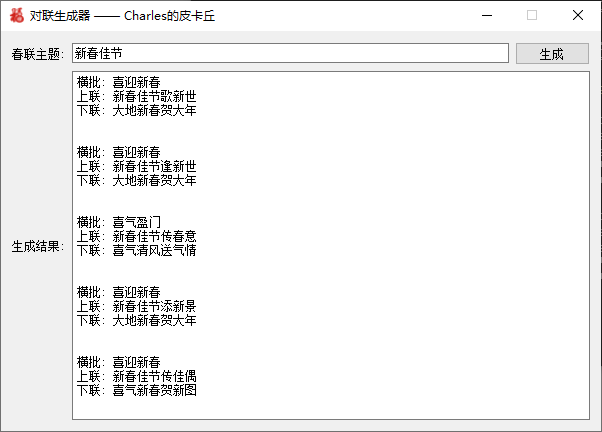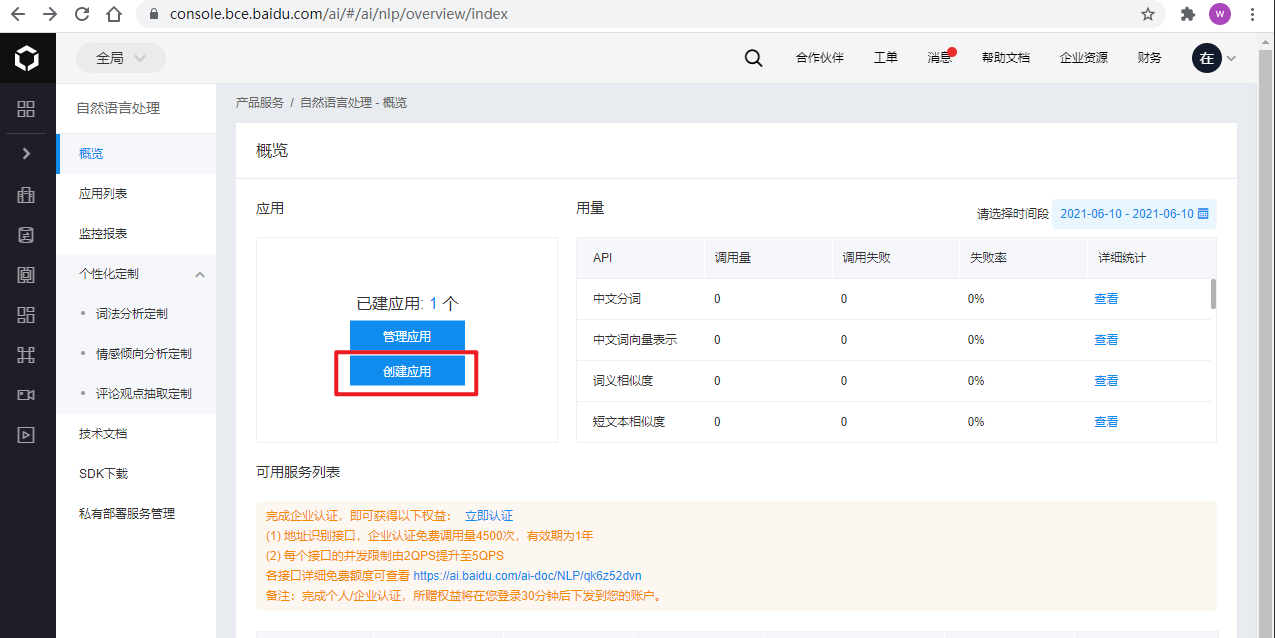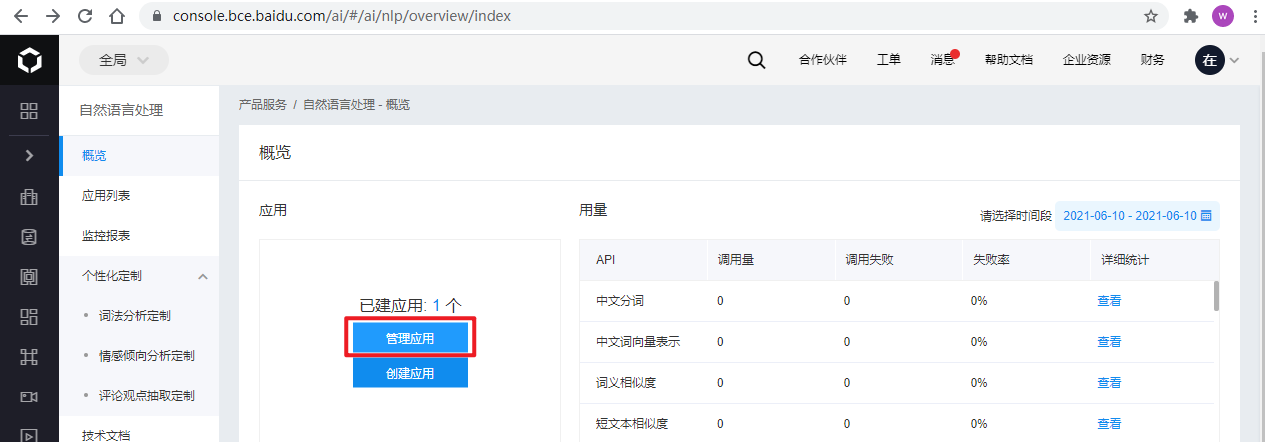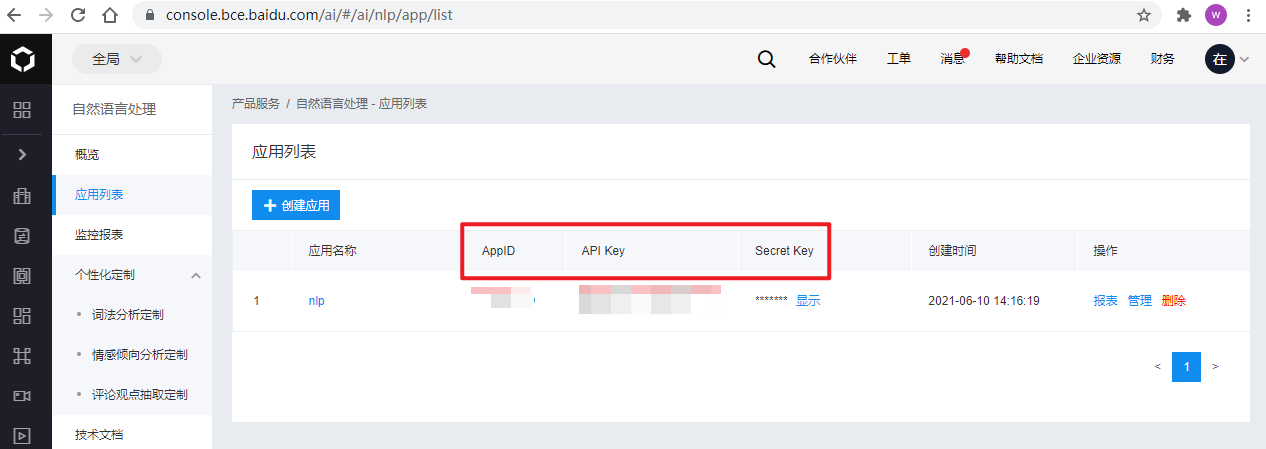1-Python - NLP之基于百度AI案例
before#
本篇主要介绍基于百度AI实现的NLP的小案例。
应用创建
无论要实现哪个案例,都需要进行接口认证,而认证的相关key在应用中提供。所以,我们要先创建NLP的应用。
访问:https://console.bce.baidu.com/ai/#/ai/nlp/overview/index, 点击创建应用,填写相关信息之后,就生成了一个应用,相关key就有了。后续需要的时候,从这个应用找key就完了。
案例1:智能春联#
所谓的智能春联,也就是通过给百度提供的相关接口发送请求,根据请求中携带的关键字生成相应的关键字。
相关文档参考:
步骤是:
- 拿着API KEY 和 SECRET KEY向鉴权接口发送请求,得到access token。
- 拿着access token向智能春联接口发送请求,得到春联内容。
基本示例:
import requests
APIKey = "rjPMODzbVeT9UMIZYqtZL9We"
SecretKey = "DPZSVhzCEy3UuNETMGGT0CGU1N0fCTYY"
headers = {
"Content-Type": "application/json"
}
# post请求也行,headers头带不带都行
access_token = requests.get(
url=f'https://aip.baidubce.com/oauth/2.0/token?grant_type=client_credentials&client_id={APIKey}&client_secret={SecretKey}'
).json()['access_token']
# print(access_token)
body = {"text": "新春", "index": 0}
response = requests.post(url=f'https://aip.baidubce.com/rpc/2.0/nlp/v1/couplets?access_token={access_token}',
headers=headers, json=body)
print(response.json()) # {'couplets': {'center': '大业辉煌', 'first': '新春事业兴大业', 'second': '喜气中华庆小华'}}
结合PyQt5实现的带界面的示例,效果如下:

下面是代码,在代码文件的同级目录需要一个张图片,icon.png:
'''
Function:
对联生成器
Author:
Charles
微信公众号:
Charles的皮卡丘
https://mp.weixin.qq.com/s/L1gmiMJ-M8T-QgSeJckYEw
pip install -i https://pypi.doubanio.com/simple PyQt5
pip install -i https://pypi.doubanio.com/simple requests
'''
import sys
import json
import random
import requests
from PyQt5 import *
from PyQt5.QtGui import *
from PyQt5.QtCore import *
from PyQt5.QtWidgets import *
from PyQt5 import QtWidgets, QtGui
'''对联生成器'''
class CoupletGenerator(QWidget):
def __init__(self, parent=None, **kwargs):
super(CoupletGenerator, self).__init__(parent)
# 初始化, 相关key需要在https://console.bce.baidu.com/#/index/overview申请
self.setWindowTitle('对联生成器 —— Charles的皮卡丘')
self.setWindowIcon(QIcon('./icon.png'))
self.setFixedSize(600, 400)
self.error_codes = {
'2': '后端连接超时请重试',
'52001': '请求超时请重试',
'52002': '系统错误请重试',
'52003': '未授权用户',
'52004': '输入解析失败',
'52005': '输入字段有误',
'52006': '输入文本长度不超过5',
'52007': '输入文本包含政治&黄色内容',
'52008': '后台服务返回错误请重试',
'54003': '访问频率受限',
'54100': '查询接口参数为空',
'54102': '无写诗结果请重试'
}
self.api_key = 'rjPMODzbVeT9UMIZYqtZL9We'
self.secret_key = 'DPZSVhzCEy3UuNETMGGT0CGU1N0fCTYY'
self.access_token = self.gettoken()
# 设置组件
self.label_title = QLabel('春联主题:')
self.line_title = QLineEdit('新春佳节')
self.generate_btn = QPushButton('生成')
self.label_result = QLabel('生成结果:')
self.text_couple = QTextEdit()
# 布局
grid = QGridLayout()
grid.addWidget(self.label_title, 1, 0)
grid.addWidget(self.line_title, 1, 1, 1, 39)
grid.addWidget(self.generate_btn, 1, 40)
grid.addWidget(self.label_result, 2, 0)
grid.addWidget(self.text_couple, 2, 1, 1, 40)
self.setLayout(grid)
# 事件关联
self.generate_btn.clicked.connect(self.generate)
'''生成对联'''
def generate(self):
if not self.line_title.text().strip():
return
url = f'https://aip.baidubce.com/rpc/2.0/nlp/v1/couplets?access_token={self.access_token}'
headers = {
'Content-Type': 'application/json'
}
all_couplets = []
index_ranges = [(0, 2), (3, 5), (6, 8), (9, 11), (12, 14)]
for idx in range(5):
params = {
'text': self.line_title.text(),
'index': random.randint(*index_ranges[idx]),
}
response = requests.post(url, headers=headers, json=params)
response_json = response.json()
center = response_json['couplets']['center']
first = response_json['couplets']['first']
second = response_json['couplets']['second']
text = f'横批: {center}\n上联: {first}\n下联: {second}'
all_couplets.append(text)
self.text_couple.setText('\n\n\n'.join(all_couplets))
'''获取token'''
def gettoken(self):
url = f'https://aip.baidubce.com/oauth/2.0/token?grant_type=client_credentials&client_id={self.api_key}&client_secret={self.secret_key}'
headers = {
'Content-Type': 'application/json; charset=UTF-8'
}
response = requests.get(url, headers=headers)
access_token = response.json()['access_token']
return access_token
'''run'''
if __name__ == '__main__':
app = QApplication(sys.argv)
client = CoupletGenerator()
client.show()
sys.exit(app.exec_())
案例2:智能写诗#
智能写诗和智能春联是一个套路。
相关文档参考:
步骤是:
- 拿着API KEY 和 SECRET KEY向鉴权接口发送请求,得到access token。
- 拿着access token向智能写诗接口发送请求,得到结果。
示例:
"""
pip install -i https://pypi.doubanio.com/simple requests
"""
import requests
APIKey = "rjPMODzbVeT9UMIZYqtZL9We"
SecretKey = "DPZSVhzCEy3UuNETMGGT0CGU1N0fCTYY"
headers = {
"Content-Type": "application/json"
}
# post请求也行,headers头带不带都行
access_token = requests.get(
url=f'https://aip.baidubce.com/oauth/2.0/token?grant_type=client_credentials&client_id={APIKey}&client_secret={SecretKey}'
).json()['access_token']
# print(access_token)
body = {"text": "新春", "index": 0}
response = requests.post(url=f'https://aip.baidubce.com/rpc/2.0/nlp/v1/poem?access_token={access_token}',
headers=headers, json=body)
print(response.json()) # {'poem': [{'content': '新春喜见燕双飞\t青瓦白门人未归\t窗外梨花千树雪\t东风带雨入帘帏', 'title': '新春'}]}







【推荐】国内首个AI IDE,深度理解中文开发场景,立即下载体验Trae
【推荐】编程新体验,更懂你的AI,立即体验豆包MarsCode编程助手
【推荐】抖音旗下AI助手豆包,你的智能百科全书,全免费不限次数
【推荐】轻量又高性能的 SSH 工具 IShell:AI 加持,快人一步